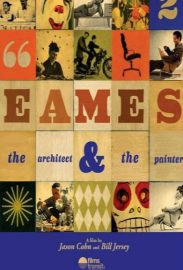
https://www.filmplatform.net/product/eames-architect-painter
The husband-and-wife team of Charles and Ray Eames are widely considered America’s most important designers. The work of Charles and Ray Eames remains for designers and consumers an ideal of design at its most virtuous – an alchemical combination of beauty and purpose. The “Eames Era,” which began in the optimistic flush of American victory in WWII, ended when Charles died in 1978. Yet their impact grows unabated.

Charles and Ray Eames gave their name to an era. “Just like Queen Victoria represents an attitude toward life that is reflected in Victorian art and literature, Eames also embodies a certain approach to life and to ideas,” notes film director Paul Schrader early in this eye-opening documentary about the iconic American industrial designers.
The “Eames Era,” which began in the optimistic flush of American victory in WWII, ended when Charles died in 1978. Yet their impact grows unabated. The work of Charles and Ray Eames remains for designers and consumers an ideal of design at its most virtuous – an alchemical combination of beauty and purpose.
Despite their unrivaled impact on American design, the steadfastly private Charles and Ray Eames have remained stubbornly hard to know beyond the giddy P.R. images they distributed to inquiring journalists while they were alive.
In Eames: The Architect and the Painter, filmmakers Jason Cohn and Bill Jersey have made the first film about Charles and Ray since their deaths — and the only film that really endeavors to peer deeply inside their collaboration, inside their sometimes troubled marriage, and beyond the doors of the “Renaissance studio” they created in a cavernous warehouse on a gritty street in Venice Beach, CA.
Narrated by James Franco, the film draws extensively from a treasure trove of archival material, primarily the visually stunning films, photographs and artifacts produced in mind-boggling volume by Charles and Ray with their talented staff during the hyper-creative forty years of the Eames Office.
Interviews with family members and design historians help guide the story, but it is the junior designers who were swept into the “24-7” world of “The Eamery,” as they called it, who provide a fascinatingly complex picture of this husband-and-wife powerhouse.
People always made the mistake that Charles and Ray — it was two brothers, right?” recalls Gordon Ashby, who worked in the Eames Office from 1959 through 1963. “Well, actually they were a married couple. And they had all of the things that happen between a married couple.”
As Franco’s narration quickly makes clear, the film’s subtitle contains a grain of irony. Ray was a brilliantly trained painter who rarely painted. Charles was an architecture school dropout who was never licensed to practice. Although contemporary design historians argue about how to delineate Charles and Ray’s respective roles in the prodigious Eames design output, the documentary instead concentrates on revealing how Charles, Ray and the other Eames Office designers dealt with those endemic questions of authorship and control.
Central to the story is Ray’s struggle to overcome 1950s gender bias and to receive proper acknowledgment for her role in the work. The film also touches on the more personal and poignant story of Charles’ infidelity and its effect on the devoted Ray.
Aside from this candid view of previously off-limits aspects of their lives, the film shares a portrait of artists applying their genius to practical problems and innovating, not out of a sense of ego, but out of sheer necessity.
The Eameses are best known for their ubiquitous furniture, but the documentary shows Charles and Ray applying the same process of inquiry to architecture, large-scale exhibitions, and their quirky, beautiful films.
Charles and Ray’s career closely tracks major developments in postwar America. As California was becoming a viable counterweight to the cultural power of New York, the Eameses moved to Los Angeles. Their light and whimsical designs, particularly the landmark house they built in the Pacific Palisades, became emblematic of a new West Coast lifestyle whose influence reached Europe, Asia, and beyond.
As American society began shifting away from manufacturing and towards an economy based on ideas and communications, the Eames Office was always a step ahead. Eames: The Architect and the Painter incorporates clips from their films and exhibitions for clients like IBM, Westinghouse, Polaroid and the U.S. government, which pushed the envelope for communicating complex ideas to mass audiences.
One of the most lasting Eamesian innovations was the technique known as “information overload.” Their 1959 project “Glimpses of the USA” featured thousands of images of American life projected simultaneously on seven enormous screens. It was shown to Russian audiences at the height of the Cold War. The strategy was later employed with great success in the landmark IBM-sponsored film “Powers of Ten,” which Eames Office designer Bill Tondreau describes as “a cosmic zoom in and out from all that is.” The popular but widely criticized bicentennial exhibition, “The World of Franklin and Jefferson” foreshadowed the layering of massive amounts of information on the Internet.
Through all their experiments and innovations, Charles and Ray rarely lost sight of one of the key tenets of their philosophy: “Take your pleasures seriously.” Even their most industrial works are permeated with a sense of sheer delight in the visual, in the simple beauty of common things, and in the pleasure that a well-made object can bring.
As Paul Schrader wryly notes, that deceptive eBay descriptor “Eames Era” has been used to sell all kinds of distinctly un-Eamesian 1950s kitsch. But Eames: The Architect and the Painter will leave audiences clear about the genuine legacy of Eames design: aesthetic refinement and functionality elevated to a higher plane by a deeply considered ethical dimension. Or as Charles and Ray often said, “The best, for the most, for the least.”